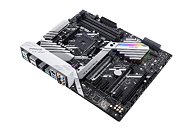- Joined
- Oct 9, 2007
- Messages
- 47,901 (7.37/day)
- Location
- Dublin, Ireland
| System Name | RBMK-1000 |
|---|---|
| Processor | AMD Ryzen 7 5700G |
| Motherboard | Gigabyte B550 AORUS Elite V2 |
| Cooling | DeepCool Gammax L240 V2 |
| Memory | 2x 16GB DDR4-3200 |
| Video Card(s) | Galax RTX 4070 Ti EX |
| Storage | Samsung 990 1TB |
| Display(s) | BenQ 1440p 60 Hz 27-inch |
| Case | Corsair Carbide 100R |
| Audio Device(s) | ASUS SupremeFX S1220A |
| Power Supply | Cooler Master MWE Gold 650W |
| Mouse | ASUS ROG Strix Impact |
| Keyboard | Gamdias Hermes E2 |
| Software | Windows 11 Pro |
AMD's socket AM4 and socket TR4 chipsets are originally designed by ASMedia. With its "Zen" family of processors being full-fledged SoCs, the motherboard "chipset" only serves to increase connectivity, and ASMedia already holds certifications for key groups such as the PCI-SIG, USB-IF, SATA-IO, NVM-Express group, etc. It's being reported now that ASMedia will develop some, if not all 500-series chipsets, with the exception of X570. The X570 will be an in-house design by AMD, which will use its own foundry partners (likely GloFo 14 nm) to manufacture it. This presents AMD with an opportunity to harden it against vulnerabilities, and have greater control over pricing, not to mention overcoming key design shortfalls of "Promontory," such as downstream PCIe connectivity.
This flies in the face of speculation that AMD would discontinue ASMedia's supply of chipset, especially in the wake of the "Chimera" vulnerability affecting "Promontory" 300-series and 400-series chipsets. The supposedly security-hardened 500-series chipset will feature PCI-Express gen 4.0 certification. What this means is that the chipset bus between the AM4/TR4 SoC and the chipset will be PCI-Express 4.0 x4 (64 Gbps), translating to double the bandwidth. It remains to be seen if the downstream PCIe lanes put out by the chipset are gen 4.0, too. Current 400-series chipsets continue to put out stale gen 2.0 lanes, compensated for by additional gen 3.0 lanes put out by the SoC. Sources also mention that ASMedia-supplied chipsets will only hit the market toward the end of 2019, which means AMD X570 could be the only 500-series chipset option between the mid-2019 launch of 3rd generation Ryzen, and late-2019. You should be able to run these processors on older socket AM4 motherboards via BIOS updates, though.

View at TechPowerUp Main Site
This flies in the face of speculation that AMD would discontinue ASMedia's supply of chipset, especially in the wake of the "Chimera" vulnerability affecting "Promontory" 300-series and 400-series chipsets. The supposedly security-hardened 500-series chipset will feature PCI-Express gen 4.0 certification. What this means is that the chipset bus between the AM4/TR4 SoC and the chipset will be PCI-Express 4.0 x4 (64 Gbps), translating to double the bandwidth. It remains to be seen if the downstream PCIe lanes put out by the chipset are gen 4.0, too. Current 400-series chipsets continue to put out stale gen 2.0 lanes, compensated for by additional gen 3.0 lanes put out by the SoC. Sources also mention that ASMedia-supplied chipsets will only hit the market toward the end of 2019, which means AMD X570 could be the only 500-series chipset option between the mid-2019 launch of 3rd generation Ryzen, and late-2019. You should be able to run these processors on older socket AM4 motherboards via BIOS updates, though.

View at TechPowerUp Main Site




